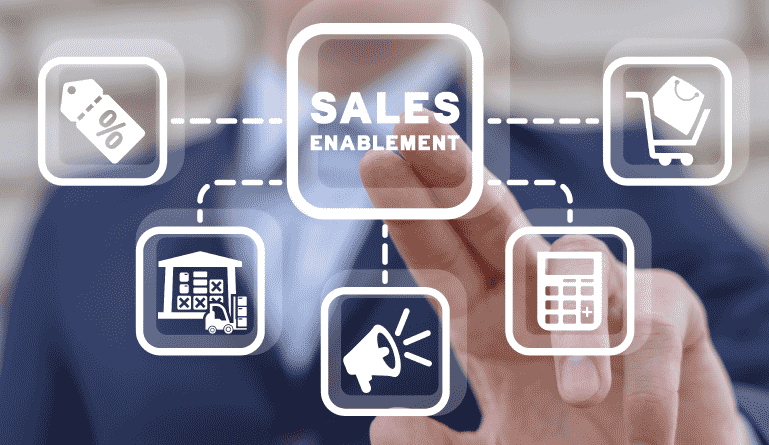Sales enablement is crucial in driving revenue growth by empowering your sales team to deliver personalized and impactful interactions at every stage of the buyer’s journey. It aligns marketing efforts with sales goals, facilitates seamless team collaboration, enhances customer experiences, and ultimately drives better business outcomes.
However, more than merely implementing a sales enablement program is required; measuring its effectiveness through critical metrics is equally essential. Read on to know which 15+ sales enablement metrics you need to track.
Core Metrics for Sales Enablement
The core metrics to measure for any sales team are:
1. Sales cycle length
The sales cycle length refers to the time it takes for a potential customer to move through the entire sales process, from initial contact to closing the deal. This metric is important because it can give valuable insights into the efficiency and effectiveness of your sales enablement strategies.
A shorter sales cycle indicates that your team can close deals more quickly, which can lead to increased revenue and higher customer satisfaction. A longer sales cycle may mean bottlenecks or inefficiencies in your process that need to be addressed.
2. Win rate
Win rate measures the percentage of deals won compared to those lost. It provides insights into the effectiveness of your sales team in converting leads into customers.
A high win rate indicates that your sales strategies, processes, and messaging resonate with prospects and lead to successful outcomes. A low win rate may suggest areas for improvement, such as refining targeting strategies or enhancing communication skills within the sales team.
3. Average deal size
This metric determines the average value of each closed deal, providing insights into the revenue generated by the sales team. By tracking and analyzing the average deal size over time, businesses can identify trends and make informed decisions to optimize their pricing strategies and increase profitability. Further, comparing the average deal size across different sales territories or teams can help identify any disparities that may require adjustments.
4. Lead response time
In today’s fast-paced business environment, customers expect quick and efficient responses when contacting a company. This metric refers to how quickly a sales team responds to leads or inquiries from potential customers. The speed of response can significantly impact the chances of converting a lead into a sale.
5. Rate of follow-up contact
The rate of follow-up contact is the speed and frequency with which sales reps follow up with leads or prospects after initial contact. A high rate of follow-up contact indicates that sales reps actively engage with potential customers, show interest in their needs, and stay top-of-mind. Conversely, a low rate could indicate missed opportunities or a lack of focus on lead conversion.
Content Utilization Metrics
Next, let’s look at the metrics reflecting how well your sales enablement content – a significant investment for any company – is performing:
1. Usage rate of sales enablement materials
A high usage rate demonstrates that sales reps understand the value of these materials and are actively incorporating them into their selling process. It also indicates that the content aligns with their needs and helps them overcome customer objections or challenges. On the other hand, a low usage rate may suggest that there could be issues with the quality, relevance, or accessibility of these resources.
2. Content engagement levels
It refers to how actively and deeply prospects and customers interact with the content provided by the sales team – for example, time spent on a webpage containing sales enablement content. This metric helps assess whether the content resonates with the target audience, captures their attention, and drives them towards desired actions.
3. Impact of content on sales outcomes
By providing valuable and relevant information to potential customers, well-crafted content helps build trust and credibility and should ultimately lead to conversion. To measure this metric, you can measure lead conversion rates before and after implementing the content strategy.
Training and Coaching Metrics
A highly skilled sales team will maximize your leads, and customers receive the products and services they need. To achieve this, you need to monitor and measure the effectiveness of your training programs:
1. Completion rates of sales training programs
One key metric to measure the effectiveness of these programs is completion rates. It indicates how many individuals complete the training, providing insight into the sales team’s level of engagement and commitment. Completion rates can help identify gaps or issues in the training program, like content relevance or delivery methods.
2. Assessment scores and knowledge retention
By evaluating the scores on sales training assessments, businesses can gauge how well their sales team is absorbing and retaining information. This metric helps identify any gaps in knowledge that may require additional training or coaching.
3. Application of training in sales scenarios
Training programs are a crucial aspect of sales enablement – however, the accurate measure of their effectiveness lies in how well sales teams can apply what they’ve learned in real-life scenarios. After all, knowledge alone is not enough to drive results, the practical application counts.
When evaluating the impact of training on sales scenarios, organizations need to measure how well sales reps can translate their learnings into actual selling situations. This can be achieved by collecting learner feedback and monitoring field performance throughout and after the training program.
Technology and Tools Adoption Metrics
Adopting the right sales enablement technology and tools is crucial for unlocking the best possible sales outcomes. That’s why it is important to measure:
1. Adoption rate of sales enablement platforms
A high adoption rate indicates that your team understands the value of these platforms and is actively incorporating them into their daily workflow, resulting in improved productivity and efficiency. On the other hand, a low adoption rate may indicate resistance or a need for more understanding of the benefits of using these platforms.
2. Usage frequency and depth of features used
Sales enablement platforms offer a range of features and tools to support sales teams. This metric provides insights into how frequently sales reps use different features and the level of engagement and proficiency with each feature.
By analyzing this data, organizations can identify which features need to be utilized or noticed by their sales team. They can then provide additional training or guidance on those specific features to ensure maximum value from the platform.
3. Impact of tools on sales productivity
The impact of these tools can be seen in various aspects of the sales process. They automate time-consuming tasks, allowing sales reps to focus on building customer relationships and closing deals. Additionally, tools provide valuable insights into customer behavior and preferences.
Performance Metrics and KPIs
These metrics provide valuable insights into individual and team performance, allowing organizations to gauge their progress toward sales targets. They include:
1. Individual and team sales targets
These targets provide clear objectives for salespeople to strive towards, ensuring alignment with overall business goals. By setting specific targets, organizations can track progress, identify areas of improvement, and drive performance.
Individual sales targets allow organizations to assess the productivity and effectiveness of each salesperson. They provide a benchmark for evaluating their ability to close deals and meet revenue goals. On the other hand, team sales targets help gauge collective performance and collaboration within the sales team.
2. Customer acquisition costs
This metric helps businesses understand how much they need to invest in acquiring new customers. It considers the expenses incurred in marketing, advertising, and sales efforts to attract and convert leads into paying customers, significantly streamlining ROI concerns.
3. Customer lifetime value impact
Customer lifetime value refers to the total revenue a customer generates over their entire relationship with a company. By analyzing this metric, businesses can gauge the long-term profitability of their customers and make informed decisions about resource allocation and marketing strategies.
A high customer lifetime value indicates that customers are making initial purchases and returning for repeat business, which is critical to sustainable growth.
In Conclusion: Building Capabilities for Advanced Metrics
As organizations strengthen their sales enablement capabilities, the goal is to progress from measuring core metrics to value-adding ones and, eventually, advanced metrics such as:
- Sales forecasting: By analyzing historical data and trends, businesses can predict future sales performance more accurately.
- Sentiment analysis: By evaluating the tone and sentiment of customer conversations, businesses can gauge customer satisfaction levels and identify any issues or pain points that need to be addressed.
- Engagement metrics on digital platforms: These measure how customers interact with online content, giving valuable insights into what resonates with them and how it impacts buying decisions.
These advanced metrics go beyond traditional measurements by leveraging technology to provide a more comprehensive understanding of sales enablement effectiveness. By incorporating these metrics into their analysis, businesses can gain a competitive edge in today’s fast-paced market environment.
Read DocuSign’s whitepaper on 8 Digital Best Practices for Sales Professionals to get more value from your sales enablement metrics and processes.







